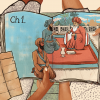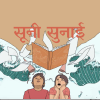Two women stand out in Sundara Ramasamy’s (Su.Ra) short stories: one is Subbammal of ‘Seethaimark Seeyakkaay Thool’ (referred to as ‘Sita Brand Shikakai Powder’ from here on) and the other is Ratnabai of the short story ‘Ratnabhain Angilam’ (referred to as ‘Ratnabai’s English’ from here on). They represent women in the giant wheel of life that revolves around the axes of wealth, education and honour. This article attempts to explore the ways in which these two characters are constructed in the narratives, intermingled with myth and fantastic imagination.
Subbammal is the wife of an artist who had immersed himself in the realm of mythological legends. The artist is sought to supply drawings for an advertisement campaign, designed to popularise the glory of ‘Sita brand shikakai powder’ across the globe. As he is about to commence his work, he attempts to visualise the mythological Sita—an image deeply registered in his mind. However, for Subbammal, the name Sita only reminds her of the various problems which she, as a woman, has faced in her life. ‘Sita goes to forest, toils hard; That rascal [Ravana] kidnaps her and tortures her. The omniscient Rama asked her to jump into fire. Where did Janaka [Janakar] disappear? Won’t a father care for his daughter’s well-being after marrying her off?’ Subbammal complains and regrets that Rama did not deserve such a person as his father-in-law.[1]
The mention of Janaka draws her father into their conversation. It was Subbammal’s father who provides them with everything: right from the house they live in, sarees that she wears, and the rice they eat. She compares her father with Janaka and feels proud that the former was not ‘as useless’ as the latter.[2] Subbabmal’s visualising and comparing of people from real life to epic characters does not stop with Janaka. When her husband informs her about the demand from a trader to draw Sita sans Rama for the advertisement, Subbammal remarks sarcastically that the man seems to be Ravana’s elder brother.[3] Her husband too compares real-life individuals with epic characters; yet, in Subbamal’s comparisons, the exploitation of labour and gender-based hierarchy are presented more vividly. When the trader asks him to draw Sita in a ‘voluptuous’ manner, he refuses to do so and sadly expresses, ‘See, how this man regards a character from a story! If Sita ever comes “alive” in front of him, what else he wouldn’t do!’.[4] And Subbammal responds, ‘He’d go to any extent. He’d even make her sit in front of the grinding stone and ask her to grind two large measures of shikakai!’.[5] Her critique of menfolk does not stop at criticising the male gaze; it goes well beyond that. Subbammal depicts Sita as the female body that could be exploited not only sexually but also beyond it in today’s consumerist milieu.
Subbammal takes Sita out of the aura of a mythological superhuman realm and visualises her as an ordinary woman in our contemporary society, still marked with gender and caste hierarchy. Her pragmatic outlook facilitates bringing the mythological narrative within the frame of everyday reality. The mythological narrative that partakes in that reality constructs her as a self-reliant, strong woman till the end. The trader who refuses to purchase the non-voluptuous portrait of Sita demands the return of the advance amount paid by him. Subbammal categorically refuses to pay and retorts how he could demand a portrait of Surpanakha after initially asking for a portrait of Sita, and, thus, again draws upon the mythological narrative of the Ramayana.
Though Subbammal’s speech is occasionally dotted with mythological characters and stories, she is firmly rooted in the real world. For example, when her husband informs her of the Rs 100 taken as advance, she shoots back asking, ‘Are they genuine notes? Or have you cut the paper and painted colours on them?’.[6] It can be stated that Subbammal, deploying a ladder of her words brings down characters of the mythology existing beyond the discourse of history to practical life or reality, and keeps them beside her. Subbammal’s identity as a woman, who is glued to practical life, is produced to the readers by interweaving the narratives of epic mythology with that of the everyday world.
While in ‘Seethaimark Seeyakkaay Thool’ using Subbammal’s speech, mythological characters collapse into our contemporary life; in the short story ‘Ratnabai’s English’, the weave of words makes Ratnabai float in a fantasy world while also rejuvenating her everyday life experience. The story’s beginning opens a window to the readers enabling them to enter a world of fantasy replete with surging emotions. The story kicks off with a letter penned, in English, by Ratnabai and addressed to her friend in which she writes about a silk saree. The following are the excerpts of the letter: ‘I won’t hesitate to call the person, who has mixed Radha’s beauty and Kannan’s (Lord Krishna’s) melodious music from his flute to create this, an artist. He who could disperse so many dreams through mixtures of colours must definitely be an artist!’.[7] The narrator describes the letter as that which contains the seeds of destiny. As it turns out, her friend requests Ratnabai to procure and send her three of those ‘miraculous’ sarees. The problem is that Ratnabai has never seen the sarees which she so passionately described in her letter and now she would have to materialise the purchase—make the sarees exist in real.
What then is the need for such a letter? Is Ratnabai a stereotypical woman, constructed in the societal discourses, as a show-off, who yearns for luxurious silk sarees? Could her letter be perceived as an account of her imagination and dream of the saree, which she cannot buy, and, in that, does it function as a device of letting out her longing and frustration? But the reader is informed by the narrative that Ratnabai’s excitement is not about the saree but writing a letter in English. Her prowess in English is attested by her friend who says, ‘Ratna, your English! How many times we have admired your English and found ourselves at a loss of words to express that admiration! Didn’t we study together? But then from where did you alone get such a command of that language?’.[8] Ratnabai’s husband goes to the extent of observing that her English is more beautiful than her physical beauty.[9] Though poverty did not allow her the luxury of pursuing higher studies in English, love for the language had completely enveloped her. Even her murmurs in sleep and lamentations are invariably in English. She frequently makes use of the dramatic English phrases she constructs: Kaalam kuthirai meethu erivanthu ennai thakkikirathu (‘Time rides on a horse as it launches an attack on me’) .[10] She finds it hard to restrain herself from using words from an English poem she has recently read. Her urge for using those ‘seductive’ words to describe the beauty of a silk garment is also the urge that pushes the narrative forward. In fact, one can say that it is this very urge that operates as the force of the narrative-attack.
Ratnabai’s love for the English language does not merely stop with her own words that she uses. Here are a few samples of the lines of a letter she writes to her friend:
‘What do you like? What do your friends like? What would they say seeing my selection? Will they say, “We agree that your friend is a genius in English; however, she is a novice in selecting the sarees?” Or, will they express that her taste displayed in her English expressions gets duly emphasised in her choice? For them to utter the latter sentence, what saree should I choose?’.[11]
Thus, in addition to choosing words for her own expressions, she chooses words for the expressions of others as well. She chooses objects that would befit her choice of words, and not the other way round. Words get the priority and the material objects that they conventionally signify, appear and merge with them later in the story. Ratnabai’s admiration for language is evident in her remark: ‘Thank God, language is a miracle’.[12]
Ratnabai’s English is not a medium through which she expresses herself; at the same time, it also does not represent her to the outer world. On the contrary, it functions as the way in which she faces the realities of life. The story depicts her as a woman caught in an incompatible marriage. Though their marriage resulted from their mutual love, her husband turns out to be a drunkard and slacks at work. Contrary to her being represented as someone, who has an eye for nuance, cleanliness and finesse, her husband is represented as an uncouth person.[13] In contrast to Ratnabai’s expertise in language and investment in mental imagination, her husband’s work deals with the human body since he is a dentist. He calls Ratnabai ‘madam’ and himself a ‘rogue’. She finds it difficult to consider her own, the ‘reckless children’ born to her with her husband.
Ratnabai’s passion for English thus protects her in an unpleasant milieu. Protection, here, does not mean an escape from this milieu or reality; rather, fantasy is very much a part of this reality in the narrative. In fact, it is fantasy that helps her get through her mundane everyday life. It gives her an identity. This identity is not that of a stereotypical gender role within families—such as mother or wife—it is the identity of the ‘best friend’ to a woman who lives several thousand kilometres away. Ratnabai’s identity emerges in and through her friendship with her close friend Ambu whom she addresses as ‘my darling!’ and ‘my dearest’ in her letters. It is this identity, borne out of friendship, which helps Ratnabai move ahead in her everyday life. Only for the sake of Ambu, she visits her husband’s room to ask for money to purchase a saree for her. Her visit to the textile shop is also for the sake of Ambu. In the narrative, Ratnabai’s only activities are, thus, organised around her friendship with Ambu. When she is not involved in these activities, she only ruminates and is drowned in her own memory.
The last sentence of the story, however, creates a chasm between the fantasy and the reality, which were intertwined till now: ‘It didn’t occur to Ratnabai at all on Wednesday morning that she should go to the bank’.[14] Ratnabai needs to pay money for the sarees that she had bought earlier and for this purpose in order to secure a bank loan, she is supposed to visit the bank on Wednesday—the day on which the bank disperses jewellery loans, as per her earlier plan. However, she does not show any interest in doing that necessary task. This sentence also indicates that fantasy, which has been deployed as a strategy to face reality until now, is now severed from it and is not useful anymore. A question now emerges: What is going to happen to Ratnabai’s identity, hitherto anchored by her intimate friendship with another woman and nurtured by fantasy?
Though the identities of the women characters in both these stories are shaped by mythology and fantasy, there are some notable differences between the two. Subbammal’s identity as a committed wife to her husband in an amicable family life gets strengthened in the everyday life which resonates with the mythology. On the other hand, Ratnabai’s identity, constructed on the plane of a friendship with another woman, in the backdrop of a turbulent family life, is left devoid of direction at the end of the story—like a mistake, like a disharmonious musical note. The end of ‘Ratnabai’s English’ suggests that this is the fate of female identity in the institution of a family governed by the ideology of heteronormativity. However, the discourse of fantasy would have lost its charm if the story had a different ending. The role of fantasy in, and its contribution to, the story would have been compromised. Indeed, ‘Ratnabai’s English’ is particularly remarkable for the finesse and richness of the language of fantasy and its immense possibilities of expression.
Translated from Tamil by Suprabala and D.I. Aravindan
Notes:
[1] Ramaswamy, Sundara Ramaswamy Siruthakthaigal, 178.
[2] ibid.
[3] ibid., 180.
[4] ibid., 184.
[5] ibid.
[6] ibid., 179.
[7] ibid., 447.
[8] ibid.
[9] ibid., 452.
[10] ibid., 450.
[11] ibid., 453.
[12] ibid.
[13] ibid., 449.
[14] ibid., 453.
Bibliography
Ramaswamy, Sundara. Sundara Ramaswamy Siruthakthaigal: Muzhuth Thoguppu. Nagercoil: Kalachuvadu Publications Pvt Ltd, 2014.











